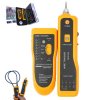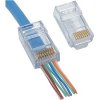Way to test what end is bad on a Cat Cable tester??
- Thread starter rufunky
- Start date
Nope, no way to know, it could even be a broken wire in the middle of the cable.
A visual inspection of each end can often determine which one isn't making good contact between the RJ45 pins and the wires inside. You should be able to see the shiny ends of all 8 wires through the front of the RJ45. A common error is not getting the wires pushed in far enough. I'm also hesitant to force the cable jacket too far into the RJ45 if I am using thick cable like Ubiquiti ToughCable, because the crimping force could damage the wires if it gets squished too hard.
A visual inspection of each end can often determine which one isn't making good contact between the RJ45 pins and the wires inside. You should be able to see the shiny ends of all 8 wires through the front of the RJ45. A common error is not getting the wires pushed in far enough. I'm also hesitant to force the cable jacket too far into the RJ45 if I am using thick cable like Ubiquiti ToughCable, because the crimping force could damage the wires if it gets squished too hard.
rufunky
Pulling my weight
- Joined
- Dec 2, 2015
- Messages
- 665
- Reaction score
- 232
Ok thanks, I wasn't sure if there was a setting on the tester or something that tested each end independently. Although I had made the mistake of all the wires not being pushed in before, this time around I made sure all the wires were pushed in all the way.
On another note.. Is Ubiquiti ToughCable the go-to for outdoor above ground runs?
On another note.. Is Ubiquiti ToughCable the go-to for outdoor above ground runs?
tangent
IPCT Contributor
- Joined
- May 12, 2016
- Messages
- 4,416
- Reaction score
- 3,649
Quoting myself from an earlier thread below:
For problems at the end of the cable, visual inspection is often the fastest option. You could run a test like the one above on each end of the cable and depending on what's going on you may be able to identify which end of the cable has the problem. But I don't think you can detect where swapped wires are with this kind of tester.The 2 most common mistakes people make when terminating cables are putting the wires in the wrong order which can occur as they push the plug on and not pushing the plug on far enough resulting in a poor connection.
Punch downs are harder to screw up, consider punching down each end of the cable and then using pre-made patch cables.
I agree it looks like one of the pictures may be wrong. When I was a kid, my dad got a partial spool of cat5 with NO color markings on the white wires free. That teaches you to terminate cable properly real quick. We cant see the side to see if the wires are in far enough. To take better pictures, put your camera in macro mode and add an external light source. If you make the same mistake on both ends of a cable, you'll pass a basic continuity test but it won't work for shit.
Best case scenario, you keep making the same mistakes over and over as you re-terminate the cable. Worst case, you bent the cable too much or pulled on it too hard and actually damaged the cable during installation.
Most computers these days can perform some fancier tests on cables to identify faults. Often you just have to find the software from the NIC mfg (eg Intel, RealTek, etc) because it may not be installed by default.

Attached is a screenshot of the RealTek utility showing cable status. It shows the status of each twisted pair. In this image one end of the cable is disconnected. If the cable is connected on both ends and working it should show normal and the same length for each pair. Differing lengths or short generally mean cable damage. These software tools are doing tdr on your cable.
This is why I like using the Easy RJ-45 jacks. The wires protrude through the end of the jack so it is almost impossible to get it wrong
https://www.amazon.com/Platinum-Tools-100010C-Connectors-Clamshell/dp/B000FI9VU2/ref=sr_1_1?ie=UTF8&qid=1507049093&sr=8-1&keywords=easy+rj+45
https://www.amazon.com/Platinum-Tools-100010C-Connectors-Clamshell/dp/B000FI9VU2/ref=sr_1_1?ie=UTF8&qid=1507049093&sr=8-1&keywords=easy+rj+45
Attachments
-
23.2 KB Views: 13
As an Amazon Associate IPCamTalk earns from qualifying purchases.
I often install Ubiquiti gear and cameras on HAM radio towers where it is always a good idea to use shielded cable to reduce interference between systems. I also don't go through a lot of cable so it isn't a huge expense to buy a spool every few years. I'm sure there are cheaper cables out there that still have good shielding.On another note.. Is Ubiquiti ToughCable the go-to for outdoor above ground runs?


